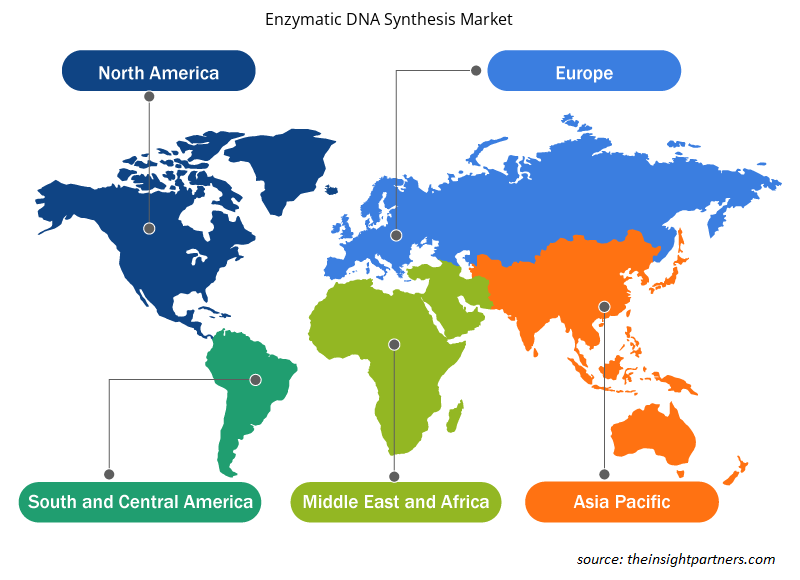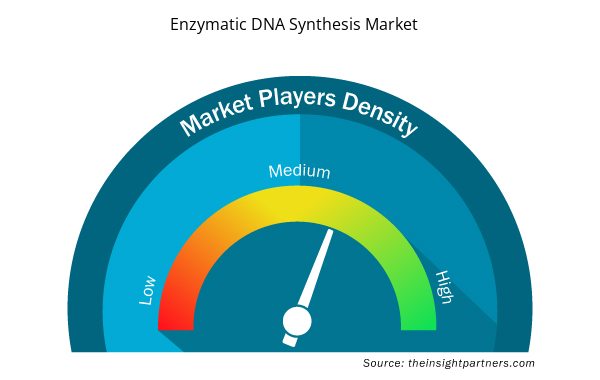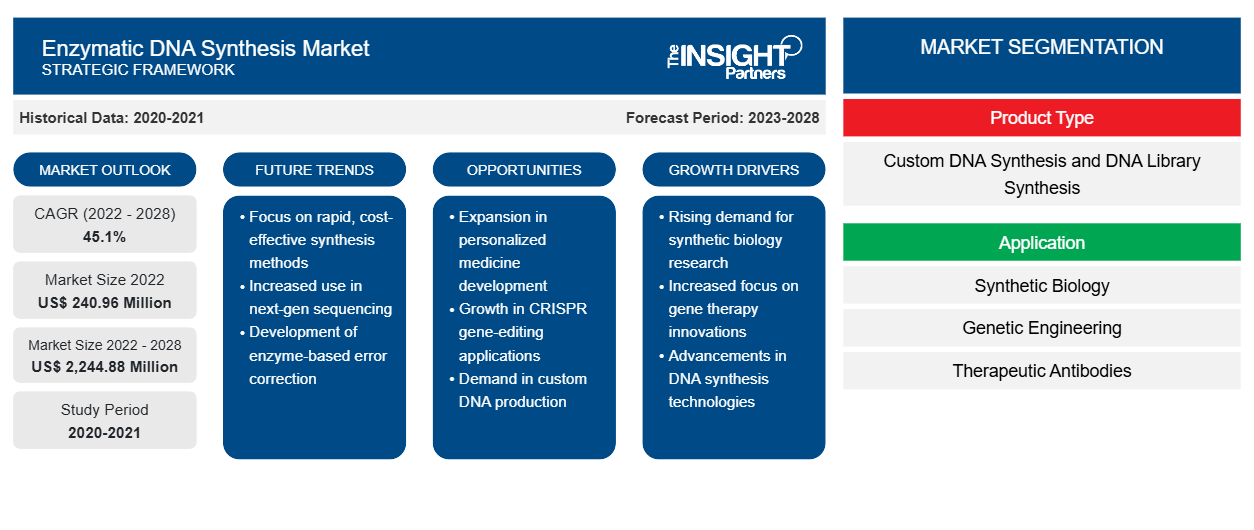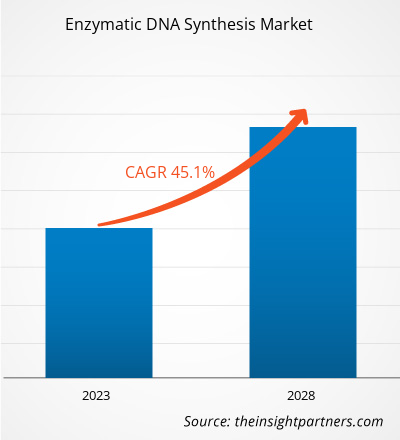[تقرير بحثي] من المتوقع أن ينمو سوق تركيب الحمض النووي الأنزيمي من 240.96 مليون دولار أمريكي في عام 2022 إلى 2،244.88 مليون دولار أمريكي بحلول عام 2028؛ ومن المتوقع أن يسجل معدل نمو سنوي مركب بنسبة 45.1٪ من عام 2022 إلى عام 2028.
إن التخليق الأنزيمي للحمض النووي هو تقنية راسخة لتخليق الحمض النووي، وهي مفيدة في علم الأحياء الاصطناعي والهندسة الوراثية وإنتاج الأجسام المضادة العلاجية وتصميم اللقاحات وغيرها من الإجراءات البيولوجية المتقدمة. كما أثبتت فائدتها في الحفاظ على مكتبات الحمض النووي وتوليف جزيئات الحمض النووي المخصصة.
رؤى حول سوق تخليق الحمض النووي الإنزيمي
ارتفاع معدل انتشار الاضطرابات الوراثية يدفع سوق تخليق الحمض النووي الإنزيمي إلى النمو
متلازمة داون واضطراب طيف التوحد والسرطان والسكري والتليف الكيسي وفقر الدم المنجلي هي بعض الاضطرابات الوراثية المعروفة. وفقًا للجينات العالمية، تم تحديد أكثر من 10000 مرض وراثي ونادر مختلف، ويعاني حوالي 400 مليون شخص من أمراض نادرة. تسبب بعض الاضطرابات الوراثية أعراضًا عند الولادة، بينما تتطور اضطرابات أخرى بمرور الوقت. يبدو أن العبء العالمي للأمراض الوراثية يتزايد. وفقًا للمركز الوطني لمعلومات التكنولوجيا الحيوية (NCBI)، وهي منظمة طبية مقرها الولايات المتحدة، اعتبارًا من نوفمبر 2021، تم تحديد الاضطرابات الوراثية في 9.4٪ من مرضى الأطفال، مع 44.7٪ من الأطفال حديثي الولادة المصابين بأمراض خطيرة. بالإضافة إلى ذلك، يعاني 13.17 مليون مريض في الولايات المتحدة من اضطرابات وراثية فريدة من نوعها. وفقًا لتقرير مراكز السيطرة على الأمراض والوقاية منها (CDC) لعام 2022، يؤثر مرض الخلايا المنجلية على حوالي 100000 أمريكي، ويحدث في 1 من كل 356 ولادة أمريكية من أصل أفريقي. التليف الكيسي، وهو مرض وراثي شائع آخر في جميع أنحاء العالم، يصيب حوالي 30 ألف شخص في الولايات المتحدة، ويتم علاج حوالي 1000 حالة جديدة سنويًا. يعتبر التخليق الأنزيمي للحمض النووي تقنية راسخة لتخليق الحمض النووي مفيدة في علم الأحياء الاصطناعي والهندسة الوراثية ودراسات الأجسام المضادة العلاجية. بالتزامن مع الاختبارات الأنزيمية، يُظهر تخليق الحمض النووي إمكانيات تشخيصية أكبر. توفر هذه الطريقة معلومات مهمة حول الأشخاص المعرضين للخطر وتساعدهم على اتخاذ قرارات مهمة فيما يتعلق بتشخيص المرض والأدوية. وبالتالي، مع انتشار الاضطرابات الوراثية المتزايد في جميع أنحاء العالم، أصبح الناس أكثر وعياً بالحاجة إلى الكشف المبكر عن هذه العيوب الجينية، مما يدفع نمو سوق التخليق الأنزيمي للحمض النووي
قم بتخصيص هذا التقرير ليناسب متطلباتك
ستحصل على تخصيص لأي تقرير - مجانًا - بما في ذلك أجزاء من هذا التقرير، أو تحليل على مستوى الدولة، وحزمة بيانات Excel، بالإضافة إلى الاستفادة من العروض والخصومات الرائعة للشركات الناشئة والجامعات
- احصل على أهم اتجاهات السوق الرئيسية لهذا التقرير.ستتضمن هذه العينة المجانية تحليلاً للبيانات، بدءًا من اتجاهات السوق وحتى التقديرات والتوقعات.
التكاليف المرتفعة والإجراءات المعقدة تعيق نمو سوق تخليق الحمض النووي الإنزيمي
إن تقنيات تخليق الحمض النووي باستخدام الإنزيم ليست ناضجة بالقدر الكافي، وهناك حاجة إلى مزيد من التحسين قبل طرحها للاستخدام على نطاق واسع. وتستند معظم هذه التقنيات إلى الإنزيم الطبيعي ديوكسينوكليوتيديل ترانسفيراز الطرفي (TdT)، والذي يستخدم في الأنظمة البيولوجية لإضافة قواعد جديدة إلى تسلسل الحمض النووي. وتعتبر الطريقة القائمة على إنزيم ديوكسينوكليوتيديل ترانسفيراز الطرفي طريقة محسنة مقارنة بالإجراء الكيميائي لأنها تتجنب إنتاج النفايات الخطرة. ومع ذلك، فإن التكاليف المرتفعة وانخفاض دقة هذا الإنزيم تعوق استخدامه في تخليق الحمض النووي في المختبر. إن إنزيم ديوكسينوكليوتيديل ترانسفيراز الطرفي متساهل للغاية، حيث يضيف قواعد خاطئة أكثر مما ينبغي. ونتيجة لذلك، فإن الأوليغوس القائمة على إنزيم ديوكسينوكليوتيديل ترانسفيراز الطرفي تحتوي على المزيد من أخطاء التسلسل وقد تتطلب نفس خطوات مراقبة الجودة بعد التخليق أو حتى المزيد، مما يزيد من وقت وتكلفة عملية التخليق. أثناء العمل مع هذا الإنزيم، يحتاج العلماء إلى إضافة المزيد من الكواشف لبناء تسلسلهم المستهدف، مما يزيد من تكلفة عملية التخليق بأكملها. إن تكلفة كل قاعدة من الحمض النووي الاصطناعي الذي يتم الحصول عليه باستخدام إنزيم ديوكسينوكليوتيديل ترانسفيراز الطرفي أعلى بكثير من تكلفة المواد الوراثية المصنعة تقليديًا. ومن ثم، فإن التكاليف المرتفعة والإجراءات المعقدة تحد من نمو سوق تركيب الحمض النووي الإنزيمي.
رؤى تعتمد على نوع المنتج
بناءً على نوع المنتج، يتم تقسيم سوق تخليق الحمض النووي الإنزيمي إلى تخليق الحمض النووي المخصص وتوليف مكتبة الحمض النووي. احتل قطاع تخليق مكتبة الحمض النووي أكبر حصة سوقية في عام 2021. علاوة على ذلك، من المتوقع أن يسجل قطاع تخليق الحمض النووي المخصص أعلى معدل نمو سنوي مركب خلال الفترة المتوقعة (2022-2028).
رؤى قائمة على التطبيق
بناءً على التطبيق، يتم تقسيم سوق تخليق الحمض النووي الإنزيمي إلى علم الأحياء الاصطناعي والهندسة الوراثية والأجسام المضادة العلاجية وتصميم اللقاحات وتطبيقات أخرى. احتل قطاع علم الأحياء الاصطناعي الحصة الأكبر من السوق في عام 2021. ومن المتوقع أن ينمو سوق تخليق الحمض النووي الإنزيمي لتطبيق الأجسام المضادة العلاجية بأعلى معدل نمو سنوي مركب خلال الفترة المتوقعة.
رؤى تعتمد على المستخدم النهائي
بناءً على المستخدم النهائي، يتم تقسيم سوق تخليق الحمض النووي الأنزيمي إلى معاهد أكاديمية وبحثية وشركات التكنولوجيا الحيوية والأدوية ومختبرات التشخيص وغيرها. احتل قطاع شركات التكنولوجيا الحيوية والأدوية الحصة الأكبر من السوق في عام 2021. ومن المتوقع أن يسجل قطاع المعاهد الأكاديمية والبحثية أعلى معدل نمو سنوي مركب في السوق خلال الفترة المتوقعة (2022-2028).
رؤى إقليمية حول سوق تخليق الحمض النووي الإنزيمي
لقد قام المحللون في Insight Partners بشرح الاتجاهات والعوامل الإقليمية المؤثرة على سوق تخليق الحمض النووي الإنزيمي طوال فترة التوقعات بشكل شامل. يناقش هذا القسم أيضًا قطاعات سوق تخليق الحمض النووي الإنزيمي والجغرافيا في جميع أنحاء أمريكا الشمالية وأوروبا ومنطقة آسيا والمحيط الهادئ والشرق الأوسط وأفريقيا وأمريكا الجنوبية والوسطى.

- احصل على البيانات الإقليمية المحددة لسوق تخليق الحمض النووي الأنزيمي
نطاق تقرير سوق تخليق الحمض النووي الإنزيمي
| سمة التقرير | تفاصيل |
|---|---|
| حجم السوق في عام 2022 | 240.96 مليون دولار أمريكي |
| حجم السوق بحلول عام 2028 | 2,244.88 مليون دولار أمريكي |
| معدل النمو السنوي المركب العالمي (2022 - 2028) | 45.1% |
| البيانات التاريخية | 2020-2021 |
| فترة التنبؤ | 2023-2028 |
| القطاعات المغطاة | حسب نوع المنتج
|
| المناطق والدول المغطاة | أمريكا الشمالية
|
| قادة السوق وملفات تعريف الشركات الرئيسية |
|
كثافة اللاعبين في سوق تخليق الحمض النووي الإنزيمي: فهم تأثيرها على ديناميكيات الأعمال
يشهد سوق تخليق الحمض النووي الأنزيمي نموًا سريعًا، مدفوعًا بالطلب المتزايد من المستخدم النهائي بسبب عوامل مثل تفضيلات المستهلك المتطورة والتقدم التكنولوجي والوعي المتزايد بفوائد المنتج. ومع ارتفاع الطلب، تعمل الشركات على توسيع عروضها والابتكار لتلبية احتياجات المستهلكين والاستفادة من الاتجاهات الناشئة، مما يؤدي إلى زيادة نمو السوق.
تشير كثافة اللاعبين في السوق إلى توزيع الشركات أو المؤسسات العاملة في سوق أو صناعة معينة. وهي تشير إلى عدد المنافسين (اللاعبين في السوق) الموجودين في مساحة سوق معينة نسبة إلى حجمها أو قيمتها السوقية الإجمالية.
الشركات الرئيسية العاملة في سوق تركيب الحمض النووي الأنزيمي هي:
- شركة تيليسيس بيو
- إيفونتيكس
- شركة أنسا للتكنولوجيا الحيوية
- كامينا بيو
- شركة جين سكريبت للتكنولوجيا الحيوية
إخلاء المسؤولية : الشركات المذكورة أعلاه ليست مرتبة بأي ترتيب معين.

- احصل على نظرة عامة على أهم اللاعبين الرئيسيين في سوق تخليق الحمض النووي الأنزيمي
رؤى مبنية على التكنولوجيا
بناءً على التكنولوجيا، يتم تقسيم سوق تخليق الحمض النووي الأنزيمي إلى SOLA وCRISPR وPCR وغيرها. يتمتع قطاع PCR بالحصة الأكبر في عام 2021 ومن المتوقع أن يستمر في اتجاه مماثل خلال فترة التنبؤ. من ناحية أخرى، من المتوقع أن يشهد قطاع CRISPR أعلى معدل نمو سنوي مركب خلال فترة التنبؤ.
الاستراتيجيات التي تتبناها الشركات في سوق تخليق الحمض النووي الإنزيمي بشكل بارز هي عمليات الاندماج والاستحواذ. فيما يلي قائمة ببعض التطورات الأخيرة التي قامت بها الشركات الرئيسية في السوق:
- في أبريل 2022، أطلقت شركة GenScript أول شريحة أشباه موصلات عالية الإنتاجية في الصناعة لتخليق الحمض النووي في المؤتمر العالمي السنوي Built With Biology. تم تطوير هذه الشريحة عالية الكثافة لتخليق الحمض النووي باستخدام تقنية شريحة أشباه الموصلات المصغرة الخاصة بشركة GenScript، وتسمح بتخليق 8.4 مليون أوليجوس فريد في وقت واحد.
- في أبريل 2022، حصلت شركة Evonetix Ltd على براءة الاختراع EP3551331B1 لتكنولوجيا التحكم الحراري الخاصة بها لتخليق الحمض النووي، وتصميم وتصنيع رقائق السيليكون الخاصة بها في أوروبا. بالإضافة إلى توسيع محفظة الملكية الفكرية لشركة Evonetix، يُنظر إلى براءة الاختراع على أنها خطوة رئيسية في استراتيجية الشركة لتطوير منصة تخليق الحمض النووي على سطح المكتب.
- في مارس 2022، جمعت شركة Molecular Assemblies, Inc. تمويلًا بقيمة 25.8 مليون دولار أمريكي من الفئة B بمشاركة مستثمر جديد وهو Casdin Capital، إلى جانب جميع المستثمرين الرئيسيين من الفئة A - Agilent Technologies وiSelect Fund وCodexis وLYFE Capital وArgonautic Ventures. وتعتزم الشركة استخدام عائدات التمويل لبدء برنامج عملاء رئيسي وتطوير تقنية تخليق الحمض النووي الأنزيمي بالكامل المملوكة للشركة نحو التسويق التجاري المبكر.
- في نوفمبر 2021، حصلت شركة DNA Script على منحة قدرها 2.2 مليون دولار أمريكي من المعهد الوطني لأبحاث الجينوم البشري (NHGRI) التابع للمعاهد الوطنية للصحة (NIH) لدعم تطوير طابعات الجيل التالي القادرة على الطباعة الأنزيمية للحمض النووي والحمض النووي الريبي الاصطناعي.
نبذة عن الشركة
- شركة تيليسيس بيو
- إيفونتيكس
- شركة أنسا للتكنولوجيا الحيوية
- كامينا بيو
- شركة جين سكريبت للتكنولوجيا الحيوية
- التجمع الجزيئي
- نص الحمض النووي
- ضوء اللمس
- تقنيات سينبيو
- تويست للعلوم البيولوجية
- التحليل التاريخي (سنتان)، السنة الأساسية، التوقعات (7 سنوات) مع معدل النمو السنوي المركب
- تحليل PEST و SWOT
- حجم السوق والقيمة / الحجم - عالميًا وإقليميًا وقطريًا
- الصناعة والمنافسة
- مجموعة بيانات Excel



Report Coverage
Revenue forecast, Company Analysis, Industry landscape, Growth factors, and Trends

Segment Covered
This text is related
to segments covered.

Regional Scope
North America, Europe, Asia Pacific, Middle East & Africa, South & Central America

Country Scope
This text is related
to country scope.
الأسئلة الشائعة
Enzymatic DNA synthesis (EDS) offers significant advantages in terms of accessibility and convenience, changing the pace and control of iteration and innovation with less environmental impact. The enzymes involved in DNA replication act coordinated to synthesize both leading and lagging strands of DNA simultaneously at the replication fork. Purported benefits of enzymatic synthesis include the ability to avoid the use of harsh chemical substances (which often result in toxic waste) and an ever-increasing ability to produce longer and longer strands of DNA, which in turn not only leads to a "more green" form of DNA synthesis, but also some incredibly powerful new uses for the longer DNA chains (e.g., vaccines, therapeutics, and data storage).
The factors that are driving the growth of the enzymatic DNA synthesis market are the rising prevalence of genetic disorders and surging number of product launches. Also, the growing demand for enzymatic DNA synthesis procedures is expected to provide opportunity for the enzymatic DNA synthesis market in forecasted period.
The enzymatic DNA synthesis market majorly consists of the players, such as Telesis Bio Inc, Evonetix, Ansa Biotechnologies, Inc., Camena Bio, GenScript Biotech Corp., Molecular Assemblie, DNA Script, Touchlight, Synbio Technologies, and Twist Bioscience.
The enzymatic DNA synthesis market is estimated to be valued at US$ 240.96 million in 2022.
The CAGR value of the enzymatic DNA synthesis market during the forecasted period of 2022-2028 is 45.1%.
The Asia Pacific region is expected to be the fastest-growing region in the enzymatic DNA synthesis market over the forecast period due to increasing government investment to provide healthcare facilities, growing advancements in healthcare infrastructure, greater adoption of advanced technologies, and rising healthcare spending in countries such as China, Japan, and India.
The enzymatic DNA synthesis market is expected to be valued at US$ 2,244.88 million in 2028.
The DNA library synthesis segment held the largest share of the market in 2022, owing to the various advantages offered by DNA library synthesis such as systematic, unbiased investigations such as high-throughput screening for discovery biology, directed evolution for protein engineering, and in vitro molecular optimization to generate mutant proteins with improved or novel properties. However, the custom DNA synthesis segment is estimated to register the highest CAGR in the market during the forecast period.
Trends and growth analysis reports related to Life Sciences : READ MORE..
The List of Companies - Enzymatic DNA Synthesis Market
- Telesis Bio Inc
- Evonetix
- Ansa Biotechnologies, Inc.
- Camena Bio
- GenScript Biotech Corp.
- Molecular Assemblies
- DNA Script
- Touchligh
- Synbio Technologies
- Twist Bioscience
The Insight Partners performs research in 4 major stages: Data Collection & Secondary Research, Primary Research, Data Analysis and Data Triangulation & Final Review.
- Data Collection and Secondary Research:
As a market research and consulting firm operating from a decade, we have published and advised several client across the globe. First step for any study will start with an assessment of currently available data and insights from existing reports. Further, historical and current market information is collected from Investor Presentations, Annual Reports, SEC Filings, etc., and other information related to company’s performance and market positioning are gathered from Paid Databases (Factiva, Hoovers, and Reuters) and various other publications available in public domain.
Several associations trade associates, technical forums, institutes, societies and organization are accessed to gain technical as well as market related insights through their publications such as research papers, blogs and press releases related to the studies are referred to get cues about the market. Further, white papers, journals, magazines, and other news articles published in last 3 years are scrutinized and analyzed to understand the current market trends.
- Primary Research:
The primarily interview analysis comprise of data obtained from industry participants interview and answers to survey questions gathered by in-house primary team.
For primary research, interviews are conducted with industry experts/CEOs/Marketing Managers/VPs/Subject Matter Experts from both demand and supply side to get a 360-degree view of the market. The primary team conducts several interviews based on the complexity of the markets to understand the various market trends and dynamics which makes research more credible and precise.
A typical research interview fulfils the following functions:
- Provides first-hand information on the market size, market trends, growth trends, competitive landscape, and outlook
- Validates and strengthens in-house secondary research findings
- Develops the analysis team’s expertise and market understanding
Primary research involves email interactions and telephone interviews for each market, category, segment, and sub-segment across geographies. The participants who typically take part in such a process include, but are not limited to:
- Industry participants: VPs, business development managers, market intelligence managers and national sales managers
- Outside experts: Valuation experts, research analysts and key opinion leaders specializing in the electronics and semiconductor industry.
Below is the breakup of our primary respondents by company, designation, and region:

Once we receive the confirmation from primary research sources or primary respondents, we finalize the base year market estimation and forecast the data as per the macroeconomic and microeconomic factors assessed during data collection.
- Data Analysis:
Once data is validated through both secondary as well as primary respondents, we finalize the market estimations by hypothesis formulation and factor analysis at regional and country level.
- Macro-Economic Factor Analysis:
We analyse macroeconomic indicators such the gross domestic product (GDP), increase in the demand for goods and services across industries, technological advancement, regional economic growth, governmental policies, the influence of COVID-19, PEST analysis, and other aspects. This analysis aids in setting benchmarks for various nations/regions and approximating market splits. Additionally, the general trend of the aforementioned components aid in determining the market's development possibilities.
- Country Level Data:
Various factors that are especially aligned to the country are taken into account to determine the market size for a certain area and country, including the presence of vendors, such as headquarters and offices, the country's GDP, demand patterns, and industry growth. To comprehend the market dynamics for the nation, a number of growth variables, inhibitors, application areas, and current market trends are researched. The aforementioned elements aid in determining the country's overall market's growth potential.
- Company Profile:
The “Table of Contents” is formulated by listing and analyzing more than 25 - 30 companies operating in the market ecosystem across geographies. However, we profile only 10 companies as a standard practice in our syndicate reports. These 10 companies comprise leading, emerging, and regional players. Nonetheless, our analysis is not restricted to the 10 listed companies, we also analyze other companies present in the market to develop a holistic view and understand the prevailing trends. The “Company Profiles” section in the report covers key facts, business description, products & services, financial information, SWOT analysis, and key developments. The financial information presented is extracted from the annual reports and official documents of the publicly listed companies. Upon collecting the information for the sections of respective companies, we verify them via various primary sources and then compile the data in respective company profiles. The company level information helps us in deriving the base number as well as in forecasting the market size.
- Developing Base Number:
Aggregation of sales statistics (2020-2022) and macro-economic factor, and other secondary and primary research insights are utilized to arrive at base number and related market shares for 2022. The data gaps are identified in this step and relevant market data is analyzed, collected from paid primary interviews or databases. On finalizing the base year market size, forecasts are developed on the basis of macro-economic, industry and market growth factors and company level analysis.
- Data Triangulation and Final Review:
The market findings and base year market size calculations are validated from supply as well as demand side. Demand side validations are based on macro-economic factor analysis and benchmarks for respective regions and countries. In case of supply side validations, revenues of major companies are estimated (in case not available) based on industry benchmark, approximate number of employees, product portfolio, and primary interviews revenues are gathered. Further revenue from target product/service segment is assessed to avoid overshooting of market statistics. In case of heavy deviations between supply and demand side values, all thes steps are repeated to achieve synchronization.
We follow an iterative model, wherein we share our research findings with Subject Matter Experts (SME’s) and Key Opinion Leaders (KOLs) until consensus view of the market is not formulated – this model negates any drastic deviation in the opinions of experts. Only validated and universally acceptable research findings are quoted in our reports.
We have important check points that we use to validate our research findings – which we call – data triangulation, where we validate the information, we generate from secondary sources with primary interviews and then we re-validate with our internal data bases and Subject matter experts. This comprehensive model enables us to deliver high quality, reliable data in shortest possible time.


 احصل على عينة مجانية لهذا التقرير
احصل على عينة مجانية لهذا التقرير